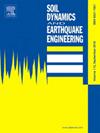Shaking table experiment on seismic response of a three-stage slope supported by anchoring lattice beam
IF 4.2
2区 工程技术
Q1 ENGINEERING, GEOLOGICAL
引用次数: 0
Abstract
Multi-stage anchoring lattice beam is widely used to support high slope in high earthquake intensity area, while the seismic behavior and interaction are not very clear. The previous studies mainly focused on a single-stage slope, while the analysis of multi-stage effect on the seismic response of anchoring lattice beam is lacking. Subsequently, a shaking table experiment was carried out to investigate the dynamic characteristics and seismic responses of a three-stage slope supported by an anchoring lattice beam. The displacement mode and the residual displacement are observed by Digital Image Correlation (DIC) technology. Kobe and Landers ground motions were input in shaking table test with an increasing order of shaking intensity. The original Kobe motion was applied at the last sequence to investigate the effect of frequency characteristic of ground motion. The results show that the acceleration response increases nonlinearly along the height of three-stage slope, and a reduction of acceleration response is observed at platform. The energy within a frequency band close to natural frequency of three-stage slope is especially amplified. The anchor takes more responsibility to resist the seismic loading, and decreases the earth pressure behind lattice beam. By setting multiple stages, the acceleration amplification and seismic earth pressure are reduced effectively. The intensity and the frequency characteristic of seismic motion affect the axial strain of anchor. The potential local failure and the frequency characteristic of seismic motion are suggested to be considered in seismic design.
锚固格构梁支撑的三级斜坡地震响应振动台实验
多级锚固格构梁广泛应用于地震高烈度地区的高边坡支护,但其地震行为和相互作用尚不十分明确。以往的研究主要集中在单级边坡上,缺乏多级对锚固格构梁地震响应的影响分析。随后,通过振动台实验研究了由锚固格构梁支撑的三级边坡的动力特性和地震响应。通过数字图像相关(DIC)技术观测了位移模式和残余位移。在振动台试验中输入了 Kobe 和 Landers 地震运动,地震强度依次递增。为了研究地表运动频率特性的影响,在最后一个序列输入了原始的神户地表运动。结果表明,加速度响应沿三级斜坡高度非线性增加,在平台处加速度响应减小。在接近三级边坡固有频率的频段内,能量尤其被放大。锚杆承担了更多抵抗地震荷载的责任,降低了格构梁后的土压力。通过多级设置,可有效降低加速度放大和地震土压力。地震运动的强度和频率特性会影响锚杆的轴向应变。建议在抗震设计中考虑潜在的局部破坏和地震运动的频率特性。
本文章由计算机程序翻译,如有差异,请以英文原文为准。
求助全文
约1分钟内获得全文
求助全文
来源期刊

Soil Dynamics and Earthquake Engineering
工程技术-地球科学综合
CiteScore
7.50
自引率
15.00%
发文量
446
审稿时长
8 months
期刊介绍:
The journal aims to encourage and enhance the role of mechanics and other disciplines as they relate to earthquake engineering by providing opportunities for the publication of the work of applied mathematicians, engineers and other applied scientists involved in solving problems closely related to the field of earthquake engineering and geotechnical earthquake engineering.
Emphasis is placed on new concepts and techniques, but case histories will also be published if they enhance the presentation and understanding of new technical concepts.
 求助内容:
求助内容: 应助结果提醒方式:
应助结果提醒方式:


